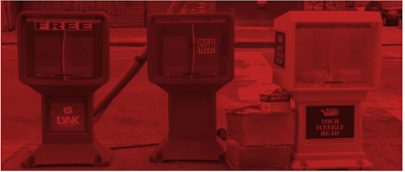FAQ: The Community News & Small Business Support Act
The Bill Text | Summary | “Dear Colleague” | Press Release | Commentary
How much money can a small business earn from this credit?
It would provide up to $5,000 in value in the first year and $2,500 in years two through five. The tax credit reimburses 80% of advertising costs, up to $5,000, in the first year (meaning a small business would have to spend $6,250 to get the full $5,000 credit). In years two through five of the bill, small businesses are able to receive 50% of their advertising spending up to $2,500 (so, small businesses would need to spend $5,000 to collect the full credit).
Can they spend it on more than one local news organization?
Yes, the credit is calculated on total advertising spending.
How do small businesses know whether the local news organization is eligible?
The bill lays out criteria for eligibility. The newsrooms are responsible for telling the small businesses whether they are eligible. Misrepresenting their eligibility would be illegal.
What if the small business doesn’t pay much in taxes?
The advertising tax credit is not refundable. In other words, if the small business pays no taxes, they won’t be able to benefit from the credit.
Can a small business use it to underwrite a public radio show?
Yes, underwriting and sponsorships are eligible advertising expenses under the bill.
Can a small business receive credit for advertising on a local TV news show?
Yes, broadcasters who have an FCC license are among the qualifying local news outlets.
How is it determined that a small business is eligible?
The small business must have 50 or fewer employees at the time that it claims the credit.
How does the payroll tax credit work?
Newsrooms get a refundable tax credit for five years, a cash benefit, of up to $25,000 in the first year and $15,000 in years two through five for each full-time local journalist. The benefit amounts to 50% of a local journalist’s compensation up to a $50,000 salary in the first year, and 30% of the salary in the last four years. That means a newsroom could see as much as $85,000 per journalist over the length of the bill.
Unlike the advertising tax credit, the payroll tax credit is refundable, meaning the value of the credit is calculated based on the salary paid, not the payroll taxes paid by the employer. So, the benefit amounts to thousands of dollars for the newsroom instead of hundreds.
Who qualifies for the payroll tax credit?
The criteria to qualify for the payroll tax credit is identical to the criteria outlined in the advertising tax credit portion of the bill, except broadcasters are not eligible for the payroll component.
Both the payroll tax credit and the advertising tax credit require that qualifying news outlets have to have at least one journalist on staff. But who qualifies as a journalist?
A full-time employee engaged in the “gathering, preparing, directing the recording of, producing, collecting, photographing, recording, writing, editing, reporting, presenting, or publishing original local community news for dissemination to the local community.” This includes an owner or proprietor as long as that person is engaged in the activities listed above.
How does the bill make sure that shady pink slime sites don’t try to benefit from the tax credits?
The bill includes a number of safeguards. First, to be eligible, newsrooms need to have at least one full time person covering local news. Many pink slime sites don’t. Beyond that, the bill prohibits news organizations that are run by, controlled by, or get significant funding from political action committees, 501c4 advocacy groups, chambers of commerce and labor unions.
How is this different from the bill that Democrats passed by partisan vote in Build Back Better?
Build Back Better only included the payroll tax credit. This bill includes a tax credit for small businesses that advertise with local news. It also includes upgraded safeguards on any tax credits benefiting local news organizations that are controlled or financed by political organizations.
Won’t getting government funding undermine the independence of the press?
This is the one criticism we take very seriously. We believe that some types of government support for the media can indeed be quite damaging. That’s why we — and most professional publishing organizations — supported this particular bill.
The content-neutral, universal nature of the bill makes it the spiritual ancestor of the Postal Subsidy that the Founding Fathers instituted, which provided low cost mailing to Federalist and Jeffersonian papers alike. So if a conservative publisher sets up a local news site to cover the town, they too would be eligible for the credit — as long as they do local reporting and meet the criteria outlined in the bill.
Why should the government bailout the media when it’s their own fault for not adapting with the times?
This bill wouldn’t benefit national media outlets. It would benefit local publishers. The people who report on the businesses on mainstreet, the high school football games and, yes, the goings on in local government. Many local news outlets have adapted with the times. They have started newsletters, planned community events and developed digital strategies. But businesses on mainstreet who used to advertise have closed, the platforms have captured much of the digital advertising market and reader habits have changed dramatically, creating a market failure – meaning journalism now costs more to make than people are willing to pay for it.
Which would be fine if local news outlets had the same community value as, say, your neighborhood Blockbuster. But when Netflix overtook Blockbuster in the movie rental market, there was no effect on government waste or the degree to which citizens felt connected to their communities. Yet, that’s exactly what’s happened as local news outlets have shuttered, which is why the Community News and Small Business Support Act is so vital.
How much will this cost?
There are not yet estimates on how much the bill would cost, but in earlier iterations, the payroll tax credit was estimated to be worth $1.67 billion over five years.





